Soil geology
| Although soil seems the end product from weathering rocks, it is merely a stage in the gigantic cycle of mineral recycling by the movement of tectonic plates. Humans use soil for their daily needs but do not sufficiently take account of its slow formation and fast loss. Discover the amazing geology of soil formation and the basic rock and soil types. How is soil formed? How does soil become fertile? What is the soil cycle? How does rainfall and evaporation affect soil and the environment? What are soil orders? |
tectonic mixing | The tectonic movement of the crustal plates sweeps sediments onto continents and underneath them where they are molten into new rock. It is a continuous process of rejuvenating continental rock. | |
rock formation | In the cauldron of Earth, new rocks are formed, to emerge through volcanoes or by being exposed after erosion. The melting pot brings minerals together, then separates them into various classes of igneous rock. |
| soil formation | Exposed to low pressure, low temperatures, water and vegetation, rocks decompose into minerals that form soil and that feed plants. | |
| soil profile | In a cross-section of soil, various zones or horizons are formed. Each has its own meaning and function. | |
| sediments | By natural erosion, soil is transported towards the sea but in the process, seggregates its fine particles to form new soils and sedimentary rock. | |
| soil orders | Soils are formed by the same conditions that formed the major ecosystems on Earth, hence their close affinity. | |
| evaporation & rainfall | Rainfall and evaporation are essential to soil fertility and productivity, but also to their sensitivity to erosion. Ideally, rainfall should just exceed evaporation, but large areas of the world do not share these favourable conditions. | |
Tectonic mixing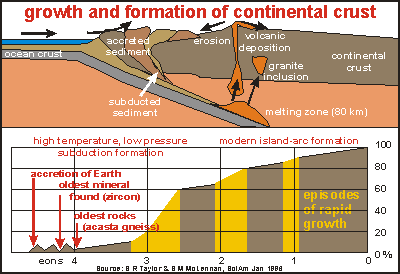 In the section oceanography/tectonic plates, the drifting of the continents and the formation of continental crust is dealt with in more detail. This diagram is part of that chapter. It shows the formation of continental crust over eons of time (billions of years), first fast, then successively more slowly (bottom chart). The top shows a cross-section through the earth's crust where ocean plate meets continent. As the plate is subducted underneath the lighter continent, it sweeps ocean and continental sediment onto the continent and also drags it down into the hot, plastic zone. Under high pressure and heat, and under the little understood 'ignition' of water, the sediment melts furiously, bubbling its way up through the continent. Particularly at its margins where the continental crust is thinnest, volcanoes are formed and hot lava deposited on the land. Ashes are spread far afield during the initial violent phases of volcanoes. Gases enter the atmosphere, only to be rained down onto sea and continent. In the section oceanography/tectonic plates, the drifting of the continents and the formation of continental crust is dealt with in more detail. This diagram is part of that chapter. It shows the formation of continental crust over eons of time (billions of years), first fast, then successively more slowly (bottom chart). The top shows a cross-section through the earth's crust where ocean plate meets continent. As the plate is subducted underneath the lighter continent, it sweeps ocean and continental sediment onto the continent and also drags it down into the hot, plastic zone. Under high pressure and heat, and under the little understood 'ignition' of water, the sediment melts furiously, bubbling its way up through the continent. Particularly at its margins where the continental crust is thinnest, volcanoes are formed and hot lava deposited on the land. Ashes are spread far afield during the initial violent phases of volcanoes. Gases enter the atmosphere, only to be rained down onto sea and continent. |
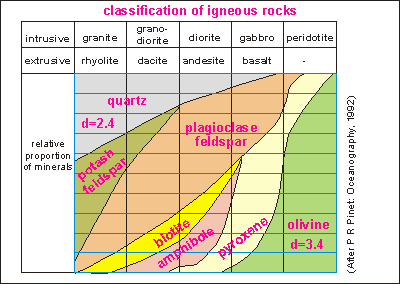 Molten magma may push itself out through the surface, forming volcanoes in the process. In its early years, a volcano belches light materials and gases under enormous pressure. Such volcanoes are 'rhyolitic' (Mt St Helens), belching dust and ash high up in the atmosphere. As the pressure in the magma chamber underneath the volcano diminishes, the volcano also calms down, eventually oozing liquid lava with ever higher density, until the pressure is insufficient to bring up any more material. The magma chamber cools off slowly and the volcano dies. Sometimes the magma chamber can't reach the surface, solidifying slowly inside the earth with all its treasures locked inside. In the process, minerals have the time to form beautiful and large crystals. The rock thus formed, shows these clearly (granite, gabbro, peridotite, precious stones).
Molten magma may push itself out through the surface, forming volcanoes in the process. In its early years, a volcano belches light materials and gases under enormous pressure. Such volcanoes are 'rhyolitic' (Mt St Helens), belching dust and ash high up in the atmosphere. As the pressure in the magma chamber underneath the volcano diminishes, the volcano also calms down, eventually oozing liquid lava with ever higher density, until the pressure is insufficient to bring up any more material. The magma chamber cools off slowly and the volcano dies. Sometimes the magma chamber can't reach the surface, solidifying slowly inside the earth with all its treasures locked inside. In the process, minerals have the time to form beautiful and large crystals. The rock thus formed, shows these clearly (granite, gabbro, peridotite, precious stones). In the diagram one can see the various kinds of igneous (from molten magma) rock and how they relate. Inside the diagram the various minerals (quartz, feldspar and so on) are mentioned and their ratios in the rock formed from it. From top left to bottom right, one can imagine the cross-section through a magma chamber, the lighter elements on top (quartz), heavier ones below (olivine). In this direction, also the density of the rock (specific mass, relative to water), changes from 2.4 for quartz to over 3.4 for olivine. The heaviest materials, sinking to the bottom of the cauldron, are the metal ores, not shown in the diagram.
Rocks formed outside the crust, and cooling rapidly, are called extrusive, whereas those formed inside by slow cooling, intrusive. The extrusive series from left to right names the kinds of rock emanating from volcanoes, as these age (rock also becomes denser). First rhyolite (frothy rock, ash) then dacite (in between), andesite (solid lava) and basalt (the crater plug). The intrusive series starts with light granite and ends with heavy peridotite. For more details, see the rock classification table.
Where do the minerals that are important for life end up? In the cauldron, they are seggregated by mass. Imagine the main substance in the cauldron is quartz SiO2 or related silicates. From the periodic table of elements, the atomic masses can be found: O=16, Si=28. The main nutrients are: N=14, Mg=24, P=30, S=32, K=39, Ca=40. Mg and Ca are found in amphibole, pyroxene, olivine, feldspars. Potash (K) in potash feldspars. Phosphorus (P), sulphur (S) and nitrogen (N) are not well represented in these rocks.
What is important to remember is that, starting from a well mixed cauldron with sediments, the formed rocks end up with different properties, and thus the soils formed from them. This is the first step in the seggregation of minerals. Sedimentation and sediment transport is another one. But let's first turn to the process of soil formation.
Two-layer clays are formed in hot, humid tropical regions, producing arable but easily dried soils. These clays are not able to hold much water, or nutrients, but are still very much better than sand.
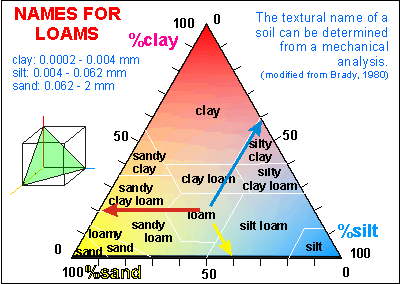 Soil's productivity is mainly due to the clays in the soils. Knowing that clay particles are very small (less than 2 microns), one can imagine that this component is easily eroded out of the soil. Its small size prevents it from sedimenting out rapidly in water, resulting in rivers, lakes and ocean water staying turbid for a long time after rains have ended.
Soil's productivity is mainly due to the clays in the soils. Knowing that clay particles are very small (less than 2 microns), one can imagine that this component is easily eroded out of the soil. Its small size prevents it from sedimenting out rapidly in water, resulting in rivers, lakes and ocean water staying turbid for a long time after rains have ended. The mix of sand, silt and clay is called a loam. In this diagram, the triangle represents all possible combinations of the three. Soil specialists use names for the various loams, as indicated in the diagram. A loam can be dried and pounded in the laboratory and passed through sieves to separate the mix by particle size. From the diagram, the official composition of 'loam' can be inferred - sand:silt:clay = 40:40:20. (Draw lines parallel to each side and read the left-hand values.)
Sand is very workable but won't hold water, or nutrients well. Loam is poor in nutrients, reasonably workable, but holds water well. Clay is difficult to work, compacts easily, but holds water and nutrients well, but is reluctant to release these to plants. As the diagram shows, the various loams derived from the three base components, have varying workability, water holding capacity and cation exchange capacity (CEC).
Not only temperature and moisture affect soil formation but also the level of the groundwater table and the steepness and elevation. As can be seen, soil formation depends on many factors, regional and local, resulting in an almost infinite number of different soils, each having different needs. Nutrients therefore, can vary considerably from patch to patch, requiring careful application and observation.
Soil profile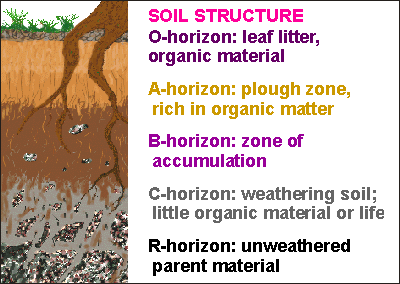 Whereas soil is formed from the rock below, it is eroded away from the top. A cover of plant life slows down erosion, allowing the soil layer to build up, but there is more going on. Whereas soil is formed from the rock below, it is eroded away from the top. A cover of plant life slows down erosion, allowing the soil layer to build up, but there is more going on. Just above the base rock, is the C-horizon, containing the recently weathered and still weathering soil. It is rich in nutrients. The A-horizon is where most plant roots are found and all soil organisms. Its nutrients have been used by plants or leached downward, so it is relatively poor in nutrients, but rich in life. By comparison, the B-horizon is the zone where new material from below and nutrients from above accumulate. Sometimes an impermeable layer or pan is formed above it (podsol), denying plants to access this rejuvenating source of new nutrients. On the surface of the soil, often a thin layer is found, rich in leaf litter and other organic material. |
| horizon | description of detailed soil horizons |
| O | consists mainly of organic matter from the vegetation, which accumulates under conditions of free aeration. |
| A | eluvial (outwash) horizon consisting mainly of mineral matter mixed with some humified (decomposed) organic matter. |
| E | strongly eluviated horizons having much less organic matter and/or iron and/or clay than the horizons underneath. Usually pale coloured and high in quartz. |
| B | illuvial (inwashed) horizon characterised by concentrations in clay, iron or organic matter. Some lime may accumulate, but if the accumulation is excessive, the horizon is named K. |
| K | horizon containing appreciable carbonate, usually mainly lime or calcium carbonate. |
| G | gleyed horizons which form under reducing (anoxic) conditions with impeded aeration, reflected in blueish, greenish or greyish colour. |
| C | weathered parent material lacking the properties of the solum and resembling more the fresh parent material. |
| R | regolith, the unconsolidated bedrock or parent material. |
Sediments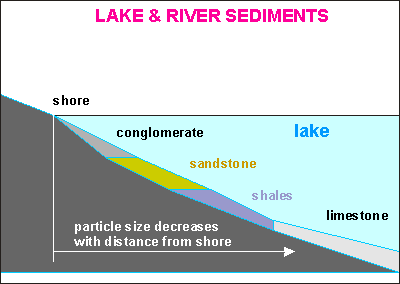 Soil erosion is a natural process, part of the gigantic cycles of minerals. As the soil erodes, its particles are transported down-hill towards ever faster flowing rivers, which eventually slow down in their lower reaches. As the water slows down, first the coarse material settles, the cobbles, shingle and gravel. Then sand, silt and finally mud. In the flood plains of a river, silt and sand are deposited with some mud, creating some of the most fertile and workable soils of the world. In estuaries, under the influence of tides and waves, fine particles are washed out and sand flats are left behind. When the sea level drops, these become workable soils but poor in nutrients. Soil erosion is a natural process, part of the gigantic cycles of minerals. As the soil erodes, its particles are transported down-hill towards ever faster flowing rivers, which eventually slow down in their lower reaches. As the water slows down, first the coarse material settles, the cobbles, shingle and gravel. Then sand, silt and finally mud. In the flood plains of a river, silt and sand are deposited with some mud, creating some of the most fertile and workable soils of the world. In estuaries, under the influence of tides and waves, fine particles are washed out and sand flats are left behind. When the sea level drops, these become workable soils but poor in nutrients. |
When subjected to extreme pressure, by being pushed deep down, or by colliding forces, sedimental rock will metamorphose into new, harder rock forms like gneiss, schist, greywacke and marble. These weather like the original igneous rocks, to form sand, silt and clay.
We've now come full circle in our description of the rock/soil/mineral cycle.
Soil orders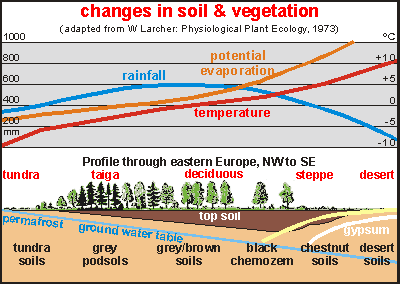 The main soil orders of the world follow the main terrestrial habitats because they depend on the same conditions of temperature and humidity. Please refer to the section oceanography/currents to study how climate comes about and where rain falls. The main soil orders of the world follow the main terrestrial habitats because they depend on the same conditions of temperature and humidity. Please refer to the section oceanography/currents to study how climate comes about and where rain falls. This diagram illustrates the principles behind the various soil orders in a north-south (left-right) soil cross-section from tundra to desert. The top part shows three graphs of temperature, rainfall and evaporation. Potential evaporation is a property of soil that can entirely be predicted from temperature. As the temperature increases, water molecules become more volatile, resulting in a predictable potential loss (potential evaporation). The difference between rainfall and evaporation is what remains for the vegetation. Large areas of the world have at least one season where this is the case. Only few places have rain in all seasons; New Zealand being one of these. |
The taiga conifer forest is only just able to grow in the cold summers. With rainfall exceeding evaporation, and soils acidified by the trees' resins, nutrients and clays are leached downward, forming grey podsols where most clay is found in the B horizon, leaving the A horizon sandy.
Deeper soils are formed in the mid-latitudinal areas, the temperate zone, where evaporation roughly equals rainfall. Deciduous forestscan now grow in the long summer months, hybernating in winter. Under these conditions, productive grey/brown soils are formed.
As the water table descends further, soils deepen, while warm, dry conditions are favourable for savannah and prairies. Populated by deep-rooting grasses that produce just enough aciditiy to retain clay but not enough to leach its nutrients. Under these conditions, fertile black chernozem soils are formed, rich in humus.
As the water table descends further, and evaporation far exceeds rainfall, soils become chestnut/cinnamon coloured and unproductive. The steppe grasslands, Mediterranean scrub and Californian chaparral are only a step away from the desert. Seasonally, these soils dry so thoroughly that instead of clays, oxides of iron are formed. These cinnamon-coloured soils contain very little clay and are very poor in humus and organic material.
Desert soils are characterised by severe erosion and slow weathering. They are very poor and easily disturbed by wind and occasional rain. Horizons of calcium-bearing deposits form, like gypsum.
Not shown in the picture are the rain forest soils. Because of extensive rainfall, the water table extends almost to the surface, for most of the year. Deep soils cannot develop and all minerals and nutrients are stored in the vegetation above and in a rich, deep organic O-horizon. Trees can grow only if some other tree sheds a leaf that becomes decomposed, or if an animal dies and decomposes. Although such ecosystems look very rich, they are not productive and are unsuitable for human exploitation.
| Evaporation and rainfall In the diagram of the previous chapter, a soil and vegetation profile was followed that ran across the most fertile regions of the USSR. with rainfall just exceeding evaporation. Very fertile black-earth regions developed, very suitable for cropping. But large areas of the world do not enjoy such balanced situations. In this chapter we'll explore how rainfall and the sun's radiation, which causes evaporation, relate. |
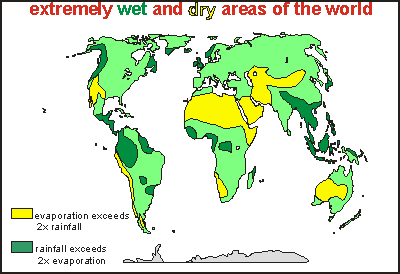 If evaporation exceeds rainfall, soils become arid. If rainfall exceeds loss, soils become boggy. In either case, productivity is reduced considerably. Where rainfall exceeds twice the potential evaporation, as is found in some tropical rainforests, the ecosystem won't sustain exploitation by humans. Likewise the soils where evaporation exceeds rainfall by a factor of two, the deserts and dry soils. These soils should either be left alone, never to be exploited by modern farming, or be farmed with utmost care. This map shows the areas that are either too dry or too wet. Note that human technology cannot improve their sustainably. If evaporation exceeds rainfall, soils become arid. If rainfall exceeds loss, soils become boggy. In either case, productivity is reduced considerably. Where rainfall exceeds twice the potential evaporation, as is found in some tropical rainforests, the ecosystem won't sustain exploitation by humans. Likewise the soils where evaporation exceeds rainfall by a factor of two, the deserts and dry soils. These soils should either be left alone, never to be exploited by modern farming, or be farmed with utmost care. This map shows the areas that are either too dry or too wet. Note that human technology cannot improve their sustainably. |
For maps of the original vegetation of the world, visit oceans/productivity.
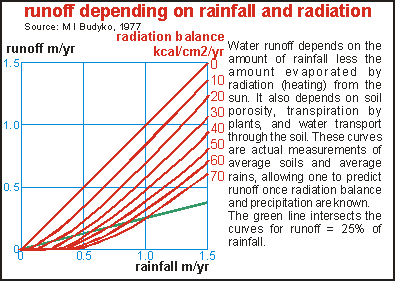 In the early seventies, advanced climatological and ecological work was done by the Russian scientist Mikhail Ivanovich Budyko, who developed and proved advanced ecological theories. Budyko observed that the heat balance of the Earth's surface drives many of its phenomena, like the weather. This heat or radiation balance at the Earth's surface, can be defined as: In the early seventies, advanced climatological and ecological work was done by the Russian scientist Mikhail Ivanovich Budyko, who developed and proved advanced ecological theories. Budyko observed that the heat balance of the Earth's surface drives many of its phenomena, like the weather. This heat or radiation balance at the Earth's surface, can be defined as: |
The curves in the diagram (radiation balance from 0 to 70) cover most areas of the world, as shown in the map below. It can be seen that runoff of 0.5m/yr is easily exceeded. If runoff is to stay below 25% of rainfall (the green line), sustainable farming is achievable only with rainfall in between 0.4 and 1.0 m/yr. In New Zealand, where the radiation balance is between 50 and 70, sustainable farming can be achieved in areas with rainfall between 0.7 and 1.0 m/yr. Notice that some runoff is needed to eluviate (wash out) excess salts from the soil. As can be seen, sustainable farming is difficult to achieve, but more about this in the chapters on erosion and sustainability.
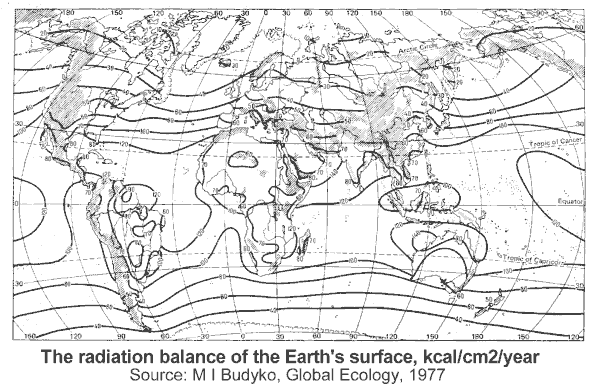
| The water balance for land surfaces and the oceans quantifies the water cycle: |
|
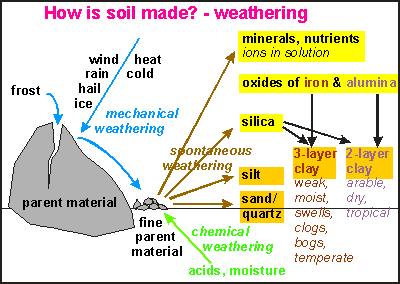 One of the most important scientific discoveries was how soil forms spontaneously from rock. Under the influence of physical factors like deformation by heat and cold, assault by wind, rain, hail and ice, and the enormous levering forces of water expanding into ice, solid rock is shattered into smaller pieces (see picture). But however small these fragments, they still have the same properties as the parent rock.
One of the most important scientific discoveries was how soil forms spontaneously from rock. Under the influence of physical factors like deformation by heat and cold, assault by wind, rain, hail and ice, and the enormous levering forces of water expanding into ice, solid rock is shattered into smaller pieces (see picture). But however small these fragments, they still have the same properties as the parent rock.